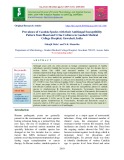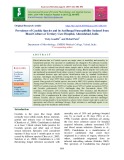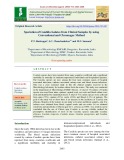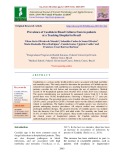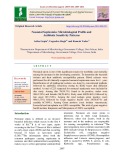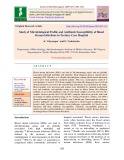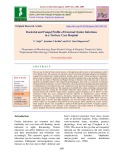
Candida in blood cultures
-
The aim of our study is to test procalcitonin (PCT) as surrogate marker of identification of Candida spp. by blood culture (BC) and real-time-polymerase chain reaction (PCR), whether alone or in association with bacteria, in septic patients. Methods: We performed a single-centre retrospective study. We reviewed the clinical charts of patients with a diagnosis of severe sepsis or septic shock treated at our general intensive care unit from March 2009 to March 2013.
 9p
9p  viisaacnewton
viisaacnewton
 26-04-2022
26-04-2022
 9
9
 1
1
 Download
Download
-
The present study was done to identify distribution of various Candida spp. to species level from blood and urine sample and to find out the antifungal susceptibility pattern of these isolated Candida isolates.
 7p
7p  nguaconbaynhay10
nguaconbaynhay10
 22-01-2021
22-01-2021
 13
13
 2
2
 Download
Download
-
Blood infection due to Candida species are major cause of morbidity and mortality in hospitalised patients. The spectrum of candidemia has changed to Non albicans Candida species and also shows resistance to commonly used azoles drugs. To study prevalence of Candida species isolated from blood culture samples and to isolate and identify different Candida species with their antifungal susceptibility testing. Blood samples were collected and incubated in automated blood culture system.
 9p
9p  trinhthamhodang1215
trinhthamhodang1215
 23-09-2020
23-09-2020
 15
15
 1
1
 Download
Download
-
Candida species have been reported from many countries worldwide and a significant morbidity & mortality in immunocompromised individuals and hospitalised patients. The Candida species are now among the four most common causes of hospital associated infections, catheter associated, urinary tract and blood stream infections. This was a cross sectional study in this the clinical samples received in the Microbiology laboratory for routine culture form the source.
 6p
6p  quenchua4
quenchua4
 06-04-2020
06-04-2020
 18
18
 2
2
 Download
Download
-
Candidemia is a serious public health problem and is associated with high morbidity and mortality rates. This study aimed to determine the prevalence of Candida species isolated from inpatients with candidemia at a teaching hospital in Brazil; characterize patients; correlate the risk factors and investigate the use of antibiotics.
 11p
11p  nguaconbaynhay4
nguaconbaynhay4
 22-03-2020
22-03-2020
 18
18
 1
1
 Download
Download
-
The aim of present study was to isolate, identify various species of Candida responsible for producing clinical Candidacies from blood culture and to determine antifungal susceptibility pattern of Candida species by disc diffusion method. study was conducted at Microbiology department P.D.U Medical college Rajkot from March 2014 to June 2015. Blood samples from suspected cases were inoculated in to Brain Heart Infusion broth were incubated at 370C and subcultured routinely.
 5p
5p  caygaocaolon3
caygaocaolon3
 27-02-2020
27-02-2020
 19
19
 0
0
 Download
Download
-
Neonatal sepsis is one of the significant reasons for morbidity and mortality among the neonates in the developing countries. To determine the bacterial isolates and their antibiotic susceptibility pattern. Blood cultures were performed for all clinically suspected neonatal septicemia cases for 1 year. Identification of all pathogenic isolates was done by conventional methods followed by antibiotic sensitivity testing by Kirby bauer disk diffusion method. A total of 225 suspected for neonatal septicemia were included in this study. Among this 78(34.
 6p
6p  nguathienthan3
nguathienthan3
 27-02-2020
27-02-2020
 26
26
 0
0
 Download
Download
-
Blood stream infections (BSIs) can lead to life-threatening sepsis and are globally associated with high morbidity and mortality. Early diagnosis plays a crucial role in managing BSI. Objective is to identify the pathogens causing blood stream infections and to know their antibiotic sensitivity pattern. This was a retrospective study of 1 year duration. A total of 1332 blood samples from clinically diagnosed cases of blood stream infections received in the microbiology laboratory were included in the study.
 11p
11p  trinhthamhodang3
trinhthamhodang3
 12-02-2020
12-02-2020
 30
30
 2
2
 Download
Download
-
The eye may be infected from external sources or through intraocular invasion of microorganisms carried by the blood stream. The common eye infections caused by bacterial and fungal pathogens are blepharitis, conjunctivitis, internal and external hordeolum, keratitis, dacryocystitis. Timely institution of appropriate therapy must be initiated to control the infections and thereby minimize the ocular morbidity.
 9p
9p  cothumenhmong1
cothumenhmong1
 08-12-2019
08-12-2019
 8
8
 0
0
 Download
Download
CHỦ ĐỀ BẠN MUỐN TÌM









